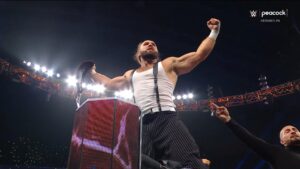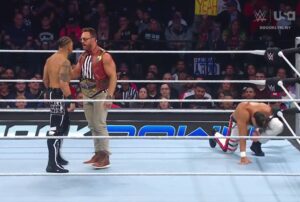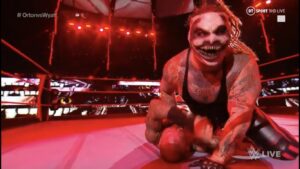In this second of three articles, James unpacks how since Wrestlemania XL changes in the relationship between WWE and its founder Vince McMahon have impacted perceptions of the new era of wrestling. Since Vince put his remaining TKO Group Holdings stocks up for sale, the company is almost disconnected professionally from the man who made WWE a global cultural brand. This has impacted AEW and WWE both in terms of creative, business and its fanbase’s perceptions.
In the first article, James unpacked how The Paul Levesque Era tried to move on from McMahonism while retaining key elements of Vince’s infrastructure. In the last, James will discuss how current fans’ wishes fulfilment and desires of AEW differ from WWE’s fanbase.
Wrestling Fans Don’t Want a Lot
Said no one ever. I’m hoping you read that with a sense of humour. If you didn’t, it does highlight an issue that some wrestling fans have. At times, some of us take ourselves and wrestling too seriously. At other times, we are inherently self-loathing.
And to be fair, we have constantly been told we are bad for wrestling for the past decade. By the market leader, wrestlers themselves (recently Rhea Ripley) and other fans. Eventually, that message gets internalised. Despite making up a core of wrestling’s audience, even during years of barren creative and monopoly.
It wasn’t that long ago historically that Triple H berated the “IWC” fans for wanting more from WWE in his infamous “me and my friend, Mark” promo. In that monologue, Triple H said one of his options was to fire the crowd.
It wasn’t that long ago that we became the authority in WWE and fans were going to be listened to. Nothing changed. Fans made their displeasure known. They hijacked shows and told WWE what and who they wanted.
As fans, we have been made to feel guilty for wanting more from wrestling. And yet fans have been described also by wrestlers and other fans as spoilt. The phrase “enjoy wrestling” is accurate in the sense yes, we should enjoy our hobby. We should appreciate our luck. Yet like telling someone to “be kind”, it can become a phrase that shuts down discussion. That asserts a right and wrong.
There is a complex relationship between wrestling promotions and fans. WWE’s relationship with the fans has been antagonist. Former WWE creative writers like David Schilling said that Vince McMahon had two words for disappointed fans. The last them. The first starts with F and has four letters. But Vince is gone.
WWE The Ten-Year Curse Broken?
Being a wrestling fan, specifically a WWE the mid-2000s until Vince left was filled with many false dawns. There seemed many times where hope for some kind of change was there. Then like the South Park meme: “and it was gone”.
My first Wrestlemania was Wrestlemania XX. Two of my heroes stood victorious at the end of the night the confetti rained down. I was at this time learning about the internet and IWC and began reading dirt sheets.
I didn’t need the internet to tell me that the men Kevin Nash had dismissed as “vanilla midgets” were given the belts like a worker of so many years gets a gold watch. Eddie Guerrero lost the belt two PPVs later. Chris Benoit still felt secondary to Triple H and Evolution.
Batista and John Cena’s rise was well-deserved, but quickly creative, more in the case of Cena, reduced him to a superhero caricature.
Scraps were given or clawed at by the wrestlers. CM Punk brought hope but again, was presented as secondary. Then Daniel Bryan/Bryan Danielson’s “Yes Movement” forced a change to the card. History repeated. Triple H took the loss and then Danielson beat Batista and Randy Orton to become world champion.
Regardless of injury and vacating the championship, it did not seem that Bryan was going to be “the guy” fans wanted. The main event spotlight went to those who fell upward in defeat. Evolution’s feuded with The Shield. It felt like an echo of ten years prior.
History seemed to be about to repeat itself for Wrestlemania XL when it looked like the main event would not include Cody Rhodes finishing the story. Backlash caused a change of plans again. The result: again one of the greatest Wrestlemania’s of all time.
Vince is Gone
The difference between all these Wrestlemanias is now Vince is gone. Last year’s Wrestlemania 39 was once again a false dawn. Cody lost and worse, the conclusion of the Raw After Mania saw Rhode viciously dismantled by a man he picked as his partner, Brock Lesnar. Whether or not this was Vince’s or Triple H’s creative, Lesnar is perceived as a Vince guy.
The feud itself turned into another neat chapter in the story. However, in the moment, it seemed an apt metaphor for Vince being back. A Vince favourite embarrasses the fans’ favourites. The promise to stay out of “weeds on the creative end” seemed another blatant lie.
The fear this year was that Cody couldn’t finish the story. Then what? But as Ryan Page put it in his article on what if Cody lost, the show would go on. Cody would not likely drop down the card. Whether or not anyone cared as much about him wouldn’t matter. The machine would keep turning. The money would still be made as it always has been.
But in giving Cody his moment, it’s just confirmed a reality fan had already realised. Vince is gone. The era of Paul Levesque gives fans whole, completed stories. Yet beyond logical storylines with clear resolved endings and a fresh newly minted figurehead to carry the company. Plus, other changes have addressed fan displeasure from previous years.
Whether this has been deliberate or not is beyond the point. As I broke down in Part 1, the general framework of WWE creative is the same. Yet Triple H’s differences in wrestling taste align with the desires of fans. “Black and Gold Era” NXT led to one of the most despised wrestlers behind the scenes becoming affectionally redubbed Papa H.
A Literal New Presentation
At the end of last year, a man referred to as Vince’s right-hand man by some, a “stooge” by others, left the company. Kevin Dunn, the former WWE Executive Producer within the IWC was a figure many disliked for more than his quick-cut camera work. Dunn’s perceived dislike of being even associated with the wrestling business alienated some.
Former WWE creative writer Alex Greenfield went as far as to call Dunn detrimental and stuck in his ways.
The drastic change in how WWE shows are produced, and how the camera lingers more on the moment and aids the story is worth praise. At points, some of the camera shots, including long tracking shots have been cinematic. This reflects many fans’ feelings about WWE being a company now of cinematic storytelling.
Fans have been excited over Easter eggs like Liv Morgan and Dominik Mysterio leaving the same dressing room. Such Easter eggs and layers have been prominent during The Bloodline storyline. The difference with WWE is that in comparison to AEW, wrestlers succumb more frequently to the invisible camera. Wrestlers don’t acknowledge watching the show or appear to carry out their business outside of TV broadcasts.
Elsewhere AEW in its storylines at the best of times has also utilized such methods. But as I will discuss in the next article, this is standard of AEW rather than shiny and new. Additionally, there are other issues in implementation where AEW’s balance of show and not tell.
Whereas WWE is more tell, their ability to show at the right time, like the previously mentioned Morgan/Mysterio/Judgement Day storyline effectively generates buzz.
Creative Satisfaction
Creatively, The Bloodline is heralded as WWE’s starting point of its creative resurgence. However, its beginnings and its impact on the growth of business in terms of merchandise and attendance happened under the stewardship of Vince. Being able to grow the groundswell of support for Cody Rhodes was a gamble that paid off in all respects.
Yet Triple H’s biggest success has been arguably beyond the top prize. In restoring the prestige of championships, Triple H has begun rebuilding trust in the process with clear long-term storytelling.
It’s both in terms of the championships’ importance as well as their superficial presentation. The recent splitting of the WWE Unified Tag Team Championship into two belts with distinct and eye-pleasing designs has been crowd-pleasing.
Gone are the Roman pennies and the generally garishly bright brand-specific colours. Attempts to build number-one contenders with tournaments or gauntlets and making title matches less frequent add to the value of the prizes. Often, championships feel earned and their holders investible.
There are exceptions. Austin Theory’s US championship run is the most notable and leads to nothing that sticks in the long-term memory. There is also the argument to be made that the emphasis on long title reigns becomes monotonous.
The defences of Roman Reign’s Undisputed World Championship from Summerslam onwards felt like a holding pattern. The payoff hit it out of the park, but the road between August and January was forgettable.
On the one hand, Rhea Ripley’s reign had few memorable title matches (Zelina Vega’s being the one I’ll most remember) and she only defended the belt ten times. On the other, unlike Roman, Rhea was a constant on Raw. Mami was actively involved in Judgement Day storylines. If anything, Rhea’s popularity only climbed.
The Intercontinental Championship
One championship reign above all others will be used as exhibit A to explain why Triple H is currently the best booker in wrestling. Gunther’s intercontinental championship reign.
Besides building Gunther into potentially the next king of the ring and future world champion, Triple H for some saved the former WALTER from a nightmare. Honestly, I was waiting for Vince to turn “The Ring General” into another smiling dancing giant. Or just another guy on the roster. The possibility seemed there.
Two birds with one stone, Triple H harnessed Gunther’s aura to restore not only the IC championship but its mythology. So deep in cultural memory is the idea that the IC belt is the workhorse championship that a generation of fans turned wrestlers believe this myth.
On an episode of WWE’s Table for Three, Bryan Danielson, Dolph Ziggler and Ryback spoke about the fan’s belief about the “curse” of the IC belt. The idea fans don’t believe it no longer means in-ring excellent or the holder may be a future world champion. They jokingly held hands to give positive thoughts towards the belt in the hope of restoring its glory.
I keep saying the word myth because the evidence to prove that Vince didn’t see it that way is there. The IC was not WWE’s first midcard championship. Nor did it start life with that prestige as the workhorse belt.
Not until perhaps Tito Santana held the championship. Savage vs. Steamboat also added to the narrative, as well as to the concept that the belt was a stepping stone to the top. Dave Lee of Dave Knows Wrestling points out in his video on the IC championship that our perceived idea is that the belt is based on selective pattern-spotting.
Fan-Made Myth
Only 9 of the 36 champions from its first 20 years went on to win the world championship. Similarly, the concept that it is the workhorse championship falters historically when considering that before Gunther The Honky Tonk Man was the longest-reigning champion. The Ultimate Warrior, another prominent IC champion was not a technical wizard.
Consider The Mountie beat Bret Hart for the championship. Later Marc Merco, Ahmed Johnson, Val Vennis, and Billy Gunn would hold the belt. These were not workhorse champions.
However, regardless that the prestige of the IC championship has largely been a culturally created myth by the fanbase, it doesn’t invalidate the joy this narrative of the IC championship gives us as fans. Its prestige and nostalgia we feel are our kayfabe. Yet it is kayfabe that some wrestlers buy into. That Triple H’s booking rewards. The fact the championship feels as special as it always should have is valid.
Fan frustration that Sami Zayn got the Wrestlemania match for the IC title over Chad Gable could be contrasted with the joy they felt when Gable post-Mania turned on Zayn. It showed more than there are plans in place. It showed the IC belt is a significant concern creatively.
However, the long-term issue with this is the predictability of long reigns. Although the value of championships has increased, the same strategy has been used with the other championships also. It’s already becoming a cliché of Triple H’s booking that long reigns are standard. Mixing things up will eventually be needed.
As with AEW booking successful strategies, they will also stagnant. But because the product is hotter, it will be overlooked or forgiven more easily.
WWE Fans Don’t Ask for Much
In tribalistic discord, something that is worth pointing out is that criticism towards WWE lingers still on the presentation of wrestling. I wrote in part 1 about how sports and entertainment are not equal partners. Wrestling under Triple H is more prominent, but the entertainment is dominant.
Wrestlers still fall upward into championship matches. Like AJ Styles challenging Cody Rhodes at Backlash, despite losing at Wrestlemania. The same thing happened with AJ in 2016 against Roman Reigns. Some fan favourites are still not utilized like fans would like them to be. Fans are calling for a change in WWE music with the removal of Def Rebel but yet nothing has happened.
Regardless the product is hot. Fans are engaged in person and online. Arenas are being packed and business is booming. Although to a degree this is separate from fan engagement.
I do not mean it disparagingly to say WWE fans didn’t want much. They, as any wrestling fan or general enjoyer of an episodic TV show wanted logic. A better, clearer presentation of their wrestlers. Clear characters and storylines delivering on promises or subverting expectations positively. Trust that their investment will be rewarded with good escapism is building.
For the time being. It’s enough progress, as long as it appears to be made and things remain hot. This does not excuse the toxic tribalism that tries to insidiously compare everything AEW or other promotions because WWE is hot, but it’s been a long time since WWE fans could brag that they were satisfied and being serviced.
The figurehead of WWE repeatedly thanked fans rather than ignoring them and undermining them as marks.
More From LWOS Pro Wrestling
Header photo – WWE – Stay tuned to the Last Word on Pro Wrestling for more on this and other stories from around the world of wrestling, as they develop. You can always count on LWOPW to be on top of the major news in the wrestling world, as well as to provide you with analysis, previews, videos, interviews, and editorials on the wrestling world.






